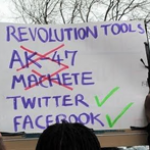Automatically, he ponders on the value of the information, asks himself about his source’s credibility, checks with his editor and studies the possibility of newspapers from the competition publishing the same news tomorrow. This work structure in journalism was the norm until a couple of years ago. Nowadays, with the abrupt explosion of social networks and the possibility of broadcasting information instantly and in real time, the role of the journalist has drastically changed.
Journalism has always been collaborative work, a result from the interaction between the reporter and the sources of information. Furthermore, the press has always been in a position of irrefutable power: the press decided what news were going to be broadcasted, what facts the community needed to know. That reality is changing noticeably. The possibility of accessing the information first hand through platforms such as Twitter and Facebook, without intermediation from the traditional media, is a big challenge for the press. Journalists are no longer the owners of the information, which now is flowing more rapidly, and originating from the most diverse sources.
Examples of this phenomenon can be found in every day life. We only need to mention Japan’s recent catastrophe: it is estimated that, on the evening when the earthquake took place, users uploaded over nine thousand videos to YouTube showing images of what happened. The sources from which the information is broadcasted have multiplied, the communication processes have accelerated, and it is possible now to access a wealth of data so huge that it has not been measured yet.
Online networking tools give the users the possibility of becoming information transmitters, allowing them to publish and share their experiences on a scale which never before has been reached. The press media must acknowledge this challenge and get involved efficiently with the web communities, taking advantage of this unique opportunity to access first hand data instantly.
This implies, of course, a strong change in the journalistic work paradigm. The journalist no longer decides what represents news and how to cover it. The social networks are making them transfer a good chunk of the editorial power to the community. And the media must recognize this potential and use it to better the quality of its contents. At the end of the day, what better word than the direct word from the protagonist to understand the events that are taking place.
Does this mean that journalism will disappear in the social networking era? Not at all. The press professionals will need to, without a doubt, acquire new skills. They have the obligation to manage the possibilities offered by the multimedia production with confidence. Also, they must strengthen their relationship with the users, participate actively in the web conversation and develop the news in a new environment that needs constant interaction with the audience.
Above all, a journalist living in the mobility and social networking era must have the ability to manage the information flow in real time. Journalists have a new challenge: the amount of data available is almost unlimited, and it is updated constantly. Therefore, they must have the professional ability to deal with that huge amount of information, identify relevant issues, verify the validity of the sources and have enough knowledge to put every situation in its proper context. They must be conscious, today more than ever, of the fact that their work centers in the audience. And audiences are not passive subjects that receive the information whilst comfortably sitting in their living room. They are a collective that can participate actively in the production of the news.

